Streambank Revegetation and Protection: A Guide for Alaska
Plant Care and Preparation
Transplanting
Transplanting is a revegetation technique that removes a plant, or plants, containing roots and shoots from one site to be replanted at another. Transplanting can take several forms generally distinguished by size: vegetation mats, plugs, sprigs and transplants (single plants). All forms require careful selection and handling in order for the transplanting effort to be successful. The important points are to keep the plant material moist and away from direct sunlight and wind while preparing and transporting the vegetation to the planting site. Harvest only the vegetation that can be planted the same day. Refer to the Plant Species Selection List for plant material suggestions.

Locate a donor site and obtain permission to harvest plants. In cases where plants are going to be destroyed by construction, consider salvaging the plants that would otherwise be lost. The conditions of the donor site need to be relatively similar to those at the transplanting site. The best time to transplant is when plants are dormant. It is essential that the plant materials stay moist and covered while in transport. Transplanting efforts can be mechanized. Trim shoots of transplants by at least 1/4 of shoot length to compensate for root loss and to promote root growth.
